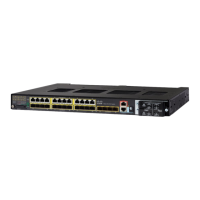575
Configuring QoS
Understanding QoS
output policy maps can contain only three unique configurations of queue limits. These three unique queue-limit
configurations can be included in as many output policy maps as there are ports on the switch. There are no limitations
on the configurations of bandwidth, priority, or shaping.
You can configure the output policy classification criteria for CPU-generated traffic by using the cpu traffic qos [cos
value | dscp value | precedence value | qos-group value] global configuration command.
Classification
Classification distinguishes one kind of traffic from another by examining the fields in the packet header. When a packet
is received, the switch examines the header and identifies all key packet fields. A packet can be classified based on an
ACL, on the DSCP, the CoS, or the IP precedence value in the packet, or by the VLAN ID. Figure 78 on page 576 has
examples of classification information carried in a Layer 2 or a Layer 3 IP packet header, using six bits from the
deprecated IP type of service (ToS) field to carry the classification information.
On ports configured as Layer 2 IEEE 802.1Q trunks, all traffic is in 802.1Q frames except for traffic in the native VLAN.
Layer 2 802.1Q frame headers have a 2-byte Tag Control Information field that carries the CoS value, called the User
Priority bits, in the three most-significant bits, and the VLAN ID value in the 12 least-significant bits. Other frame
types cannot carry Layer 2 CoS values.
Layer 2 CoS values range from 0 to 7.
Layer 3 IP packets can carry either an IP precedence value or a DSCP value. QoS supports the use of either value
because DSCP values are backward-compatible with IP precedence values.
IP precedence values range from 0 to 7. DSCP values range from 0 to 63.
Output remarking is based on the Layer 2 or Layer 3 marking type, marking value and packet type.
